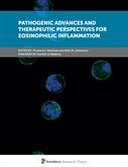Explore

Pathogenic Advances and Therapeutic Perspectives for Eosinophilic Inflammation
Mats W. Johansson and Florence E. Roufosse
2018
0 Ungluers have
Faved this Work
Login to Fave
With the recent approval of the first eosinophil-depleting therapeutic agents targeting the IL-5 pathway for treatment of severe eosinophilic asthma, eosinophils and eosinophilic disorders are in the limelight. Indeed, setbacks during clinical development of these compounds have revealed how much remains to be known about eosinophil biology in vivo, and have nurtured profuse research both on basic eosinophil biology and on pathogenic disease mechanisms, in order to better delineate the most meaningful targets for innovative therapeutic strategies. On one hand, variable degrees of eosinophil depletion observed in some compartments during IL-5-targeted treatment indicate that certain eosinophil subsets may not rely on this cytokine and/or that other important pro-eosinophilic mediators and signaling pathways are operative in vivo. On the other hand, it is increasingly clear that disorders involving eosinophils such as asthma are the final outcome of complex interactions between diverse cell types and mediators, beyond eosinophils and IL-5. These include type 2 helper T (Th2) cells and innate lymphoid cells, mast cells, and a variety of factors that either activate eosinophils or are released by them. Although a considerable amount of research has focused on asthma because it is a common condition and because management of severe asthma remains a major challenge, several rare eosinophilic disorders with more homogenous features have proven to be extremely useful models to reach a better understanding of the involvement of eosinophils in tissue damage and dysfunction, and of the micro-environmental interactions operating within the complex network of eosinophilic inflammation. Unraveling this interplay has resulted in advances in the development of molecular tools to detect disease subsets and to monitor therapeutic responses, and in identification of promising new therapeutic targets. This Research Topic dedicated to eosinophilic conditions covers aspects of the biology of eosinophils and closely related cells of particular relevance for drug development, reports on translational research investigating pathogenic mechanisms of specific eosinophilic disorders in humans that will likely result in significant changes in the way patients are managed, and presents an overview of the current advancement of targeted drug development for these conditions, with a special focus on asthma.
This book is included in DOAB.
Why read this book? Have your say.
You must be logged in to comment.
Rights Information
Are you the author or publisher of this work? If so, you can claim it as yours by registering as an Unglue.it rights holder.Downloads
This work has been downloaded 394 times via unglue.it ebook links.
- 110 - mobi (CC BY) at Unglue.it.
- 168 - epub (CC BY) at Unglue.it.
- 116 - pdf (CC BY) at Unglue.it.
Keywords
- Asthma
- Eosinophil Biology
- Eosinophilic Esophagitis
- Hypereosinophilic Syndrome
- ILC2
- mast cell
- medicine
- Th2 cell
Links
DOI: 10.3389/978-2-88945-624-6Editions

